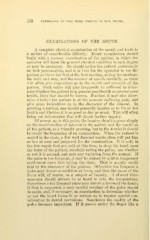Page 314 - My FlipBook
P. 314
178 PATHOLOGY OF THE HAED TISSUES OF THE TEETH. ;
EXAMINATIONS OF THE MOUTH.
A complete physical examination of the mouth and teeth is
a matter of considerable difficulty. Every examination should
begin with a cursory examination of the patient, in which the
operator will learn the general physical condition in such degree
as may be necessary. He should notice the patient particularly
on first presentation, and it is best for the operator to see the
patient on his or her feet at the first meeting, noting the carriage,
the walk and step, and the manner of speech carefully, as these
will often give indications as to the health and strength, of the
person. Such notice will also frequently be sufficient to deter-
mine whether the patient is in general good health or general poor
health, facts that should be known. Further, it may also deter-
mine whether the patient is at the moment suffering pain, and
give some indications as to the character of the ailment. In
greeting a patient, one should generally inquire as to his or her
health and whether it is as good to-day as usual. This will often
bring out information that will direct further inquiry.
Of course, up to this point, the inquiry should appear simply
as the manifestation of interest in the patient and the condition
of the patient, as a friendly greeting, but to the dentist it should
be really the beginning of an examination. When the patient is
seated in the chair, a few well-directed words often will put him
or her at ease and prepared for the examination. It is well, in
the few words that are said at this time, to drop the hand upon
the wrist of the patient, carefully noting the pulse ; see whether
or not it is normal, and note any variation from the normal. If
the pulse is too frequent, it may be caused by a little temporary
excitement upon first taking the chair. That is usually easily
told by the demeanor of the patient. Otherwise too frequent a
pulse may denote a condition of fever, and then the cause of the
fever will, of course, be a subject of inquiry. A clinical ther-
mometer should always be at hand to take the temperature.
Sometimes a too frequent pulse may denote a lesion of the heart
if that is suspected, a very careful scrutiny of the pulse should
be made, and, if necessary, an examination to determine whether
or not the heart lesion is so serious as to require special con-
sideration in dental operations. Sometimes the quality of the
pulse becomes important. If it passes under the finger like a


